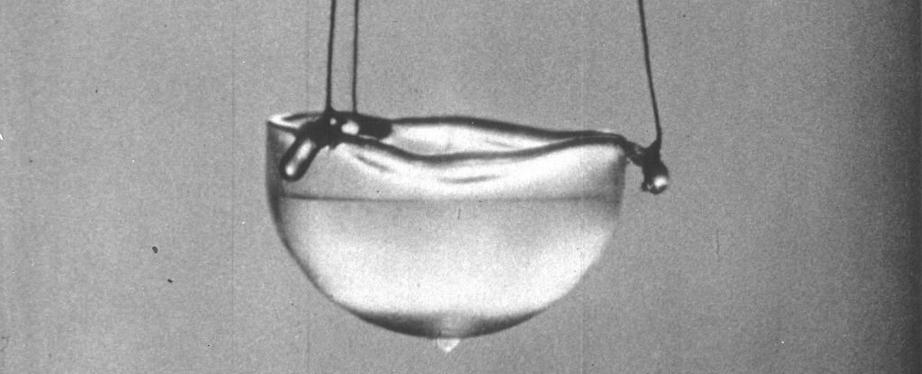A bizarre physics law is making superfluid helium behave like an actual black hole
"It points to a deeper understanding of reality."
Of all the laws of physics, this is arguably one of the strangest - scientists have discovered that the forces controlling the behaviour of a black hole's event horizon are also at play in superfluid helium, an extraordinary liquid that flows without friction.

This entanglement area law has now been observed at both the vast scale of black holes and the atomic scale of cold helium, and could be the key to finally establishing the long sought-after quantum theory of gravity - the solution to one of the deepest problems in theoretical physics today.
The fact that an entanglement area law can apply to both black holes and helium "is weird," says one of the team, physicist Adrian Del Maestro from the University of Vermont, "and it points to a deeper understanding of reality."
Black holes are strange enough on their own, but their relationship to entropy - the disorder of the Universe - is something that renowned physicist (and soon-to-be space tourist) Stephen Hawking found himself particularly absorbed by.
Entropy is how we describe the progression of a system from order to disorder - an untouched egg has low entropy, but a scrambled egg has high entropy.
And just as you can't unscramble an egg, a system can only ever progress from low to high entropy - in our Universe, at least.
Thanks to entropy, the arrow of time only ever moves forward, and since the moment of the Big Bang, the Universe and everything in it has been gradually moving towards heightened chaos.
In the 1970s, Hawking and fellow theoretical physicist Jacob Bekenstein discovered that when matter is unfortunate enough to wander too close to the event horizon of a black hole and fall in, the information that's then added to the black hole - a form of entropy - only increases as fast as the black hole's surface area increases.
That's pretty weird, because the increasing volume of the black hole doesn't seem to be a factor.
"If you double the size of a box, you expect to be able to double the amount of information in that box," physicist Christopher Herdman of the University of Waterloo in Canada, who wasn't involved in the study, told Science News.
Think of it like a filing cabinet - it wouldn't make any sense to use only its surface area measurements to figure out how many files you could fit inside, without taking its volume into consideration.
But that's what Hawking and Bekenstein discovered in black holes out in deep space, and it now looks like this counter-intuitive entanglement area law also applies to special types of atoms in our labs.
"We have found the same type of law is obeyed for quantum information in superfluid helium," says Del Maestro in a press statement.
To figure this out, the team came up with an exact simulation of superfluid helium-4 - helium that has been chilled to just 2 degrees above absolute zero. Absolute zero (0 Kelvin, -273.15°C, or -459.67°F) is the absolute limit of cold in the Universe.
At this point, the helium transforms from a gas into a fluid with zero viscosity, which allows it to flow without any loss of kinetic energy. That means if you put some superfluid helium in a cup and gave it a spin, that helium would literally spin forever.
This state of matter is so strange, it has the ability to flow 'upwards' against gravity, and climb up and over the sides of a dish:
In superfluid helium, the individual atoms that made up the substance can no longer be identified as separate entities - they've become quantum entangled with one another, and now share an existence.
When Del Maestro and his colleagues uploaded their simulation to two supercomputers, they were able to run separate simulations of 64 helium atoms as they transitioned to a superfluid.
Within this superfluid, they established two hypothetical sections - a sphere of superfluid, and the superfluid that surrounded it - and kept track of the amount of entangled quantum information shared between them as the sphere was increased.
If you think back to the black holes, this entangled quantum information is analogous to the information falling over the event horizon to increase the entropy inside.
Just like what Hawking and Bekenstein had found, they watched as the amount of entangled quantum information shared between two regions the superfluid was determined by the surface area of the sphere, but not its volume.
"Like a holograph, it seems that a three-dimensional volume of space is entirely encoded on its two-dimensional surface. Just like a black hole," the team describes.
According to Emily Conover at Science News, while the phenomenon had previously been predicted in superfluids, this is the first time that it has been demonstrated in simulations of a naturally occurring state of matter.
And that's important, because the phenomenon of quantum entanglement does not gel with the standard model of physics, and made Einstein himself deeply uncomfortable, but it's here to stay, and we need better ways of studying it.
"Entanglement is non-classical information shared between parts of a quantum state. [It's] the characteristic trait of quantum mechanics that is most foreign to our classical reality," Del Maestro says in a press statement.
"Our classical theory of gravity relies on knowing exactly the shape or geometry of space-time."
As theories that explain the behaviour of all the vast and tiny things in our Universe, Einstein's theory of relativity and quantum mechanics don't mesh, and one of the most significant problems in modern physics is finding a way to combine the two into a universal quantum theory of gravity.
Maybe finally being able to watch the strangeness of quantum entanglement in a naturally occurring state of matter will get us closer to that goal.
The research was published in Nature Physics.
